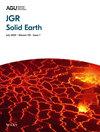Clay Minerals and Continental-Scale Remagnetization: A Case Study of South American Neoproterozoic Carbonates
IF 3.9
2区 地球科学
Q1 GEOCHEMISTRY & GEOPHYSICS
引用次数: 0
Abstract
The Neoproterozoic carbonate rocks of the Araras Group (Amazon Craton) and the Sete-Lagoas and Salitre Formations (São Francisco Craton) share a statistically indistinguishable single-polarity (reversed) characteristic direction. This direction is associated with paleomagnetic poles that do not align with the expected directions for primary detrital remanence. We employ a combination of classical rock magnetic properties and micro imaging/chemical analysis (in thin sections) using synchrotron radiation to examine these remagnetized carbonate rocks. Magnetic data indicate that most samples lack the anomalous hysteresis properties typically associated with carbonate remagnetization (except for distorted loops). Through a combination of Scanning Electron Microscopy with Energy Dispersive X-ray Spectroscopy (SEM-EDS), X-ray Fluorescence (XRF), and X-ray Absorption Spectroscopy (XAS), we identified subhedral/anhedral magnetite, or spherical grains with a core-shell structure of magnetite surrounded by maghemite. These grains are within the pseudo-single domain size range, as do most of the iron sulfides, and are spatially associated with potassium-bearing aluminosilicates. While fluid percolation and organic matter maturation play a role, smectite-illitization appears to be crucial for the growth of these phases. X-ray diffraction analysis, in addition, identifies these silicates as predominantly highly crystalline illite, suggesting exposure to epizone temperatures. These temperatures were likely reached during the final stages of the Gondwana assembly (Cambrian), but remanence was only locked in afterward, in successive cooling events during the Early Middle Ordovician. This is supported by the carbonates' paleomagnetic pole positions compared to Gondwana's apparent polar wander path, and the absence of reversals, contrasting with the high reversal frequency of the Late Ediacaran/Cambrian.粘土矿物与大陆尺度重磁化:南美洲新新生代碳酸盐岩案例研究
Araras 组(亚马逊克拉通)和 Sete-Lagoas 及 Salitre 地层(圣弗朗西斯科克拉通)的新元古代碳酸盐岩具有统计上难以区分的单极性(反向)特征方向。该方向与古地磁极不一致,与原生碎屑剩磁的预期方向不一致。我们采用经典岩石磁性和同步辐射显微成像/化学分析(薄片)相结合的方法来研究这些再磁化碳酸盐岩。磁性数据表明,大多数样本缺乏与碳酸盐再磁化相关的典型异常磁滞特性(扭曲环除外)。通过结合使用扫描电子显微镜与能量色散 X 射线光谱法(SEM-EDS)、X 射线荧光法(XRF)和 X 射线吸收光谱法(XAS),我们确定了亚方/正方体磁铁矿,或具有磁铁矿核壳结构的球形晶粒,其周围为方镁石。与大多数硫化铁一样,这些晶粒也属于伪单畴尺寸范围,并在空间上与含钾铝硅酸盐相关联。虽然流体渗流和有机物成熟起到了一定的作用,但铁闪长岩的点火似乎对这些相的生长至关重要。此外,X 射线衍射分析表明,这些硅酸盐主要是高度结晶的伊利石,这表明这些硅酸盐暴露在外显子温度下。这些温度很可能是在冈瓦纳集合(寒武纪)的最后阶段达到的,但在此之后,即奥陶纪中早期的连续冷却过程中才锁定了剩磁。碳酸盐岩的古地磁极位置与冈瓦纳明显的极地漫游路径相比没有发生逆转,这与晚埃迪卡拉/寒武纪的高逆转频率形成了鲜明对比。
本文章由计算机程序翻译,如有差异,请以英文原文为准。
求助全文
约1分钟内获得全文
求助全文
来源期刊

Journal of Geophysical Research: Solid Earth
Earth and Planetary Sciences-Geophysics
CiteScore
7.50
自引率
15.40%
发文量
559
期刊介绍:
The Journal of Geophysical Research: Solid Earth serves as the premier publication for the breadth of solid Earth geophysics including (in alphabetical order): electromagnetic methods; exploration geophysics; geodesy and gravity; geodynamics, rheology, and plate kinematics; geomagnetism and paleomagnetism; hydrogeophysics; Instruments, techniques, and models; solid Earth interactions with the cryosphere, atmosphere, oceans, and climate; marine geology and geophysics; natural and anthropogenic hazards; near surface geophysics; petrology, geochemistry, and mineralogy; planet Earth physics and chemistry; rock mechanics and deformation; seismology; tectonophysics; and volcanology.
JGR: Solid Earth has long distinguished itself as the venue for publication of Research Articles backed solidly by data and as well as presenting theoretical and numerical developments with broad applications. Research Articles published in JGR: Solid Earth have had long-term impacts in their fields.
JGR: Solid Earth provides a venue for special issues and special themes based on conferences, workshops, and community initiatives. JGR: Solid Earth also publishes Commentaries on research and emerging trends in the field; these are commissioned by the editors, and suggestion are welcome.
 求助内容:
求助内容: 应助结果提醒方式:
应助结果提醒方式:


